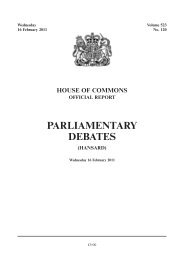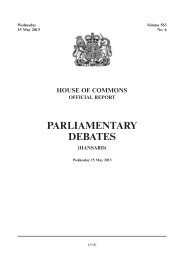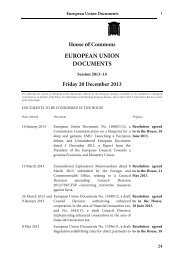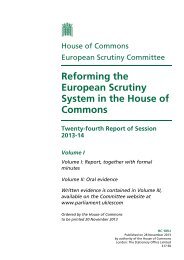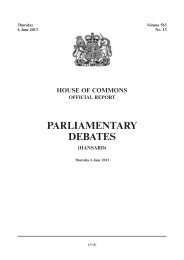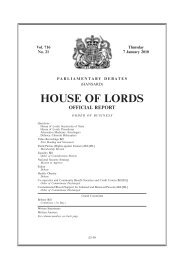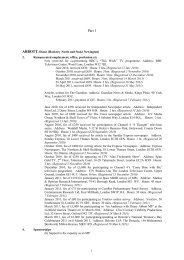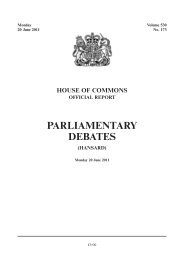Ticketing and Concessionary Travel on Public Transport - United ...
Ticketing and Concessionary Travel on Public Transport - United ...
Ticketing and Concessionary Travel on Public Transport - United ...
You also want an ePaper? Increase the reach of your titles
YUMPU automatically turns print PDFs into web optimized ePapers that Google loves.
<strong>Transport</strong> Committee: Evidence Ev 93<br />
allows Light rail <str<strong>on</strong>g>and</str<strong>on</strong>g> Commuter services to operate under Driver Only c<strong>on</strong>diti<strong>on</strong>s with c<strong>on</strong>sequent<br />
reliability, cost <str<strong>on</strong>g>and</str<strong>on</strong>g> performance benefits as there is also no need to resource the train or stati<strong>on</strong>s for full<br />
ticket checking. As an example of this, surveys c<strong>on</strong>ducted in 2002 showed ticket-less travel rates of 15%<br />
am<strong>on</strong>g local passengers <strong>on</strong> l<strong>on</strong>g distance trains in the Wolverhampt<strong>on</strong>—Coventry corridor compared to 6%<br />
<strong>on</strong> local services. The Centro area Penalty Fares scheme does not apply to l<strong>on</strong>ger distance trains, <str<strong>on</strong>g>and</str<strong>on</strong>g> this<br />
tends to make these services more attractive to fare evaders. This evidence suggests that a suitably targeted<br />
Penalty Fares regime can halve the fare evasi<strong>on</strong> rate.<br />
13. Proper processes are also required to follow up unpaid fares, via debt collecti<strong>on</strong>, or for irregularities<br />
to proceed to more serious enforcement such as prosecuti<strong>on</strong> under the legislati<strong>on</strong> described. This also<br />
requires inspecti<strong>on</strong> staV to be trained in PACE <str<strong>on</strong>g>and</str<strong>on</strong>g> SPOE procedures so that they can collect the proper<br />
evidence <str<strong>on</strong>g>and</str<strong>on</strong>g> it can be suitably presented. Feedback to staV <strong>on</strong> this is important to improve their<br />
performance. All revenue protecti<strong>on</strong> back-oYce <str<strong>on</strong>g>and</str<strong>on</strong>g> debt recovery/prosecuti<strong>on</strong> processes <str<strong>on</strong>g>and</str<strong>on</strong>g> related work<br />
can be outsourced with the supplier taking some of the risk, <str<strong>on</strong>g>and</str<strong>on</strong>g> thus no net additi<strong>on</strong>al costs. While there<br />
has to be a formal process for appeals <strong>on</strong> Penalty Fares, derived from the legislati<strong>on</strong>, there is less c<strong>on</strong>sistency<br />
in the other procedures. There is always a balance to be struck between customer service, deterring genuine<br />
fare evasi<strong>on</strong> <str<strong>on</strong>g>and</str<strong>on</strong>g> maximising revenue. Experience already shows that yield managed train specific tickets<br />
generate a large volume of unpaid fares notices when passengers use the wr<strong>on</strong>g train, with potentially<br />
adverse customer service c<strong>on</strong>sequences. These must also be processed properly.<br />
14. The re-use or re-cycling of open or l<strong>on</strong>g-dated tickets is c<strong>on</strong>sidered to be a significant revenue risk,<br />
so the system must ensure they are cancelled. On-train staV must be provided with suitable devices to cancel<br />
tickets which carry some informati<strong>on</strong> about the individual <str<strong>on</strong>g>and</str<strong>on</strong>g> date (such equipment is readily available but<br />
often not used). Misuse of this kind is otherwise diYcult to detect but some anecdotal evidence for it<br />
gathered from informal sources suggests that it may be the most significant risk <strong>on</strong> l<strong>on</strong>ger distance services.<br />
Day of travel validity <strong>on</strong>ly should apply <strong>on</strong> tickets for journeys of ' c50 miles with excepti<strong>on</strong>s for known<br />
shorter distance stay away markets such as airports. This is normal practice <strong>on</strong> urban systems <str<strong>on</strong>g>and</str<strong>on</strong>g><br />
throughout the L<strong>on</strong>d<strong>on</strong> area. Rail operators can take advantage of the “invisible” security arrangements<br />
associated with new ticketing systems, while exploiting new technologies such as Print at Home <str<strong>on</strong>g>and</str<strong>on</strong>g> Mobile<br />
Ph<strong>on</strong>e displays with some care.<br />
15. Revenue protecti<strong>on</strong> <strong>on</strong> many l<strong>on</strong>ger distance <str<strong>on</strong>g>and</str<strong>on</strong>g> rural services is left largely to c<strong>on</strong>ductors (train<br />
managers). Evidence suggests that train c<strong>on</strong>ductors may develop their own internal targets or norms for<br />
revenue collected <str<strong>on</strong>g>and</str<strong>on</strong>g> do not breach them. Full ticket checks are often carried out <strong>on</strong> the first leg of a journey,<br />
but can be spasmodic thereafter. C<strong>on</strong>trol of the train doors by c<strong>on</strong>ductors regularly inhibits serious revenue<br />
protecti<strong>on</strong> activity, particularly where stati<strong>on</strong> stops are frequent, <str<strong>on</strong>g>and</str<strong>on</strong>g> where such staV are provided <strong>on</strong><br />
suburban services they do little useful revenue c<strong>on</strong>trol or customer service work. Situati<strong>on</strong>s have also been<br />
allowed to develop that are diYcult for <strong>on</strong> train staV to h<str<strong>on</strong>g>and</str<strong>on</strong>g>le, with heavy flows for short journeys <str<strong>on</strong>g>and</str<strong>on</strong>g> a<br />
lot of revenue between staVed stati<strong>on</strong>s is being collected <strong>on</strong> train. Where ticket oYces <str<strong>on</strong>g>and</str<strong>on</strong>g> other stati<strong>on</strong>based<br />
ticket issue facilities are provided no discounts should be available <strong>on</strong> train, as this otherwise<br />
encourages a “pay-when-challenged” culture. Where Penalty Fares are not in force the rail Nati<strong>on</strong>al<br />
C<strong>on</strong>diti<strong>on</strong>s of Carriage address this <str<strong>on</strong>g>and</str<strong>on</strong>g> st<str<strong>on</strong>g>and</str<strong>on</strong>g>ard fares should apply, <str<strong>on</strong>g>and</str<strong>on</strong>g> the fact they are often not has<br />
allowed a situati<strong>on</strong> to develop that can overwhelm <strong>on</strong> train resources, <str<strong>on</strong>g>and</str<strong>on</strong>g> lead to lost revenue.<br />
16. One current issue in L<strong>on</strong>d<strong>on</strong> is the extensi<strong>on</strong> to TOCs of the TfL Oyster Pay-as-you-Go (PAYG)<br />
system. One of the primary reas<strong>on</strong>s advanced for their reluctance is a perceived revenue protecti<strong>on</strong> risk in<br />
an envir<strong>on</strong>ment with a number of open stati<strong>on</strong>s, in c<strong>on</strong>trast to the gated network of the Underground. The<br />
problem starts with the TOCs own lack of underst<str<strong>on</strong>g>and</str<strong>on</strong>g>ing of their revenue c<strong>on</strong>trol risks because so little<br />
reliable survey work has been undertaken as to the extent <str<strong>on</strong>g>and</str<strong>on</strong>g> reas<strong>on</strong>s for fare evasi<strong>on</strong>. While there is some<br />
evidence from surveys in the inner L<strong>on</strong>d<strong>on</strong> area that fare evasi<strong>on</strong> rates can be high, this can be attributed<br />
to ticket purchase arrangements <str<strong>on</strong>g>and</str<strong>on</strong>g> a lax enforcement regime. The reality, as evidence from the existing<br />
PAYG operati<strong>on</strong> can c<strong>on</strong>firm, is that the system can improve rather then worsen revenue c<strong>on</strong>trol because<br />
ticket purchase is simplified. While the TOCs have invested in ticket gates at busier stati<strong>on</strong>s in the L<strong>on</strong>d<strong>on</strong><br />
area this has tended to c<strong>on</strong>centrate resources at those stati<strong>on</strong>s <str<strong>on</strong>g>and</str<strong>on</strong>g> to foster a belief that such equipment is<br />
essential to their revenue c<strong>on</strong>trol strategy. This approach has been encouraged by the DfT in the franchise<br />
bidding process, where installati<strong>on</strong> of ticket gates is called for.<br />
17. Some local stati<strong>on</strong> c<strong>on</strong>trols will assist revenue protecti<strong>on</strong> <strong>on</strong> the nati<strong>on</strong>al rail network, including the<br />
ticket gates at a number of stati<strong>on</strong>s, but this will <strong>on</strong>ly impact <strong>on</strong> short distance travel. Ticket gates <strong>on</strong>ly<br />
protect a minimum fare <str<strong>on</strong>g>and</str<strong>on</strong>g> can encourage short booking to circumvent them. The technology does not<br />
properly address time or specific train restricti<strong>on</strong>s, <str<strong>on</strong>g>and</str<strong>on</strong>g> does not deal with length of journey, discount<br />
entitlement or class of travel. There is a particular need to check discount entitlement, especially Railcards,<br />
so supplementary or <strong>on</strong> train checks are still necessary. Gates do not address the forms of fraud comm<strong>on</strong>ly<br />
found <strong>on</strong> l<strong>on</strong>ger distance trains such as travel <strong>on</strong> an incorrect service, railcard misuse, transferred or re-use<br />
of tickets, <str<strong>on</strong>g>and</str<strong>on</strong>g> out-of-class or over-distance travel. Claims that ticket gates improve security <str<strong>on</strong>g>and</str<strong>on</strong>g> reduce<br />
crime <str<strong>on</strong>g>and</str<strong>on</strong>g> v<str<strong>on</strong>g>and</str<strong>on</strong>g>alism at stati<strong>on</strong>s are unproven. They may displace such activity to outside the paid area or<br />
to other stati<strong>on</strong>s, <str<strong>on</strong>g>and</str<strong>on</strong>g> any measured improvement is more likely to be associated with the provisi<strong>on</strong> of more<br />
visible staV or equipment such as CCTV. Modern ticket styles <str<strong>on</strong>g>and</str<strong>on</strong>g> time/ train restricti<strong>on</strong>s, not to menti<strong>on</strong><br />
luggage etc, do not fit well with gates, <str<strong>on</strong>g>and</str<strong>on</strong>g> many tickets remain outside the scope of automatic operati<strong>on</strong>,<br />
despite the replacement of <strong>on</strong>-train issues by the latest mobile machine with magnetic stripe tickets. The



